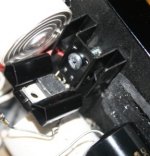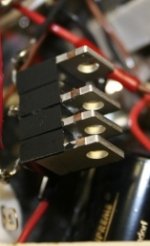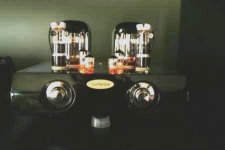It's been a little while since there was such a discussion here so I'd like to start one. Simply stated, everyone has their own preferences. What sounds good to one person may not sound good to another so where possible, we must use objective criteria also.
I propose we all pitch in and discuss our favorite ( to date ) 6SN7 grading it on the objective and subjective qualities of linearity, frequency response, clarity, low distortion, transparency and just listening pleasure.
I have listened to a few 6SN7s, the various Sylvanias, the RCAs, Raytheons, etc. but I just got a pair of Russian metal base rounded hole plate "OTK" stamped MELZ manufactured 6N8S specimens.
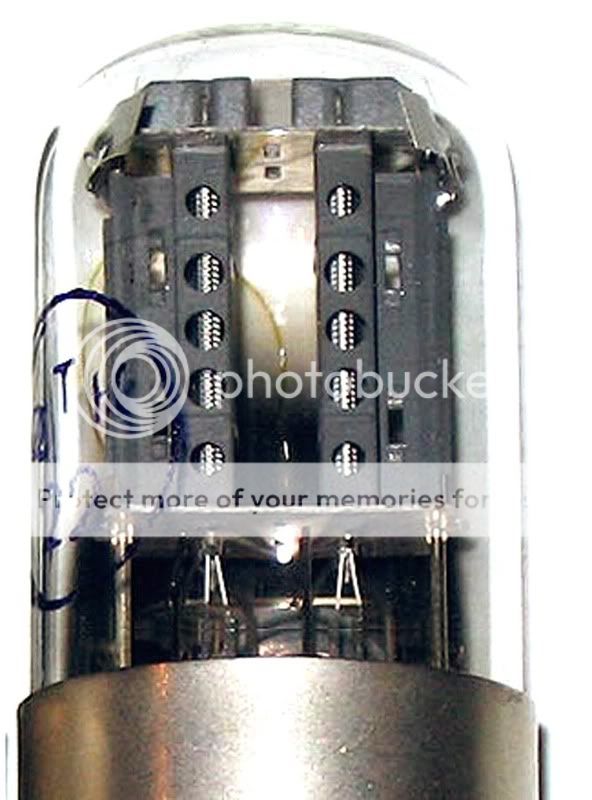
Unfortunately I have only the subjective grading methods but wow! The clarity! The additional instruments that can be heard! The depth! The incredible frequency response! It was like the dead waking to a beautiful mountain sunrise with gentle breezes, distant birds and a huge thundering waterfall. The formerly dead would be awestruck by this aural pleasure as I was by these tubes. They have my vote for the Ultimate 6SN7.
I propose we all pitch in and discuss our favorite ( to date ) 6SN7 grading it on the objective and subjective qualities of linearity, frequency response, clarity, low distortion, transparency and just listening pleasure.
I have listened to a few 6SN7s, the various Sylvanias, the RCAs, Raytheons, etc. but I just got a pair of Russian metal base rounded hole plate "OTK" stamped MELZ manufactured 6N8S specimens.

Unfortunately I have only the subjective grading methods but wow! The clarity! The additional instruments that can be heard! The depth! The incredible frequency response! It was like the dead waking to a beautiful mountain sunrise with gentle breezes, distant birds and a huge thundering waterfall. The formerly dead would be awestruck by this aural pleasure as I was by these tubes. They have my vote for the Ultimate 6SN7.
alternatively, they have a spec that just happens to hit the frequencies that align with your pattern of hearing loss as long as they are installed in your amp and its tied to your source and speakers, in your listening room.
Glad you found some that work so well for you though.
Glad you found some that work so well for you though.
The ultimate 6SN7 for me wasn't a 6SN7 at all. I replaced the 6SN7s in my Supratek Chenin preamp with CCS loaded 2C22 single triodes, biased to 3.4V using (4) Cree SiC Schottky Diodes on the cathode. To say they were MUCH MUCH better is an understatement. The 2C22 is roughly equivalent to 1/2 of a 6SN7, but the anode and grid are taken out via top caps.
Bass is clearer and more defined, mids are to die for, treble is sparkling without being grating. Using the CCS I am able to replace both sections of the 6SN7 with a single 2C22 and still have plenty of gain.
Picture #1 is of the cascoded IXYS 10M45S CCS, #2 is of the (4) SiC diodes for bias, #3 is of the Preamp with the 2C22 tubes installed. I used a socket adapter initially due to the different tube pinouts, but I have since made the install permanent by punching holes in the top plate for the wires to pass through, so the adapters shown in photo #3 are no longer there.
Bass is clearer and more defined, mids are to die for, treble is sparkling without being grating. Using the CCS I am able to replace both sections of the 6SN7 with a single 2C22 and still have plenty of gain.
Picture #1 is of the cascoded IXYS 10M45S CCS, #2 is of the (4) SiC diodes for bias, #3 is of the Preamp with the 2C22 tubes installed. I used a socket adapter initially due to the different tube pinouts, but I have since made the install permanent by punching holes in the top plate for the wires to pass through, so the adapters shown in photo #3 are no longer there.
Attachments
we must use objective criteria also.
...
Unfortunately I have only the subjective grading methods but
So, your point was???
Surely you must realize (and your own post illustrates the futility) that "objective" somehow fails to apply at this forum?
Tim
CV1988. Quiet, clean. Problem is, it's tall so won't fit under the lid in many builds.
What lid?
Seriously though for good karmic vibes I find the Sylvania 6SN7/GA/GB pretty hard to beat at least into late 1970s era production. They're well balanced spectrally speaking, clean and detailed. They're still among the more reasonably priced brands of this type - personally I prefer them to the several pairs of vintage Tungsols I own. I would rank the GE and Raytheon versions as poor sounding in comparison to either the Sylvania or Tungsol.
Brimar made some nice ones too, tend to be a bit lusher and more romantic sounding, were (are) favored by some for this reason.
My comments are of course very subjective, on the linearity front I have not seen huge differences between brands and vintages except in a few extreme cases. Distortion spectra does seem to be influenced by geometry. I guess that may be why I like the Sylvanias so much. All of my designs are 0 fdbk and I have used 6SN7 in line stages and the driver stages of power amplifiers. I have heard a few amps and pre-amps designed by others that used the 6SN7.. I would consider my exposure to other hardware using them pretty limited. Results are likely to be different depending on design constraints, listening preferences, and other system components.
So, your point was???
Surely you must realize (and your own post illustrates the futility) that "objective" somehow fails to apply at this forum?
Tim
Some of us here actually do place a lot of stock in objective measurements, but ultimately we all listen with our ears.
There are all sorts of people participating here, some, like me, have engineering backgrounds and try hard to correlate what we measure with what we believe we are hearing. I can't always make the correlation, but I strive for good electrical performance within the context of what (I think) is reasonable for the technology I am using.
Others have neither the resources, experience or in some cases the inclination to do the deep dive required.
Designing is all about the art of compromise, understanding how what you are doing affects other circuit parameters that may not necessarily improve when you make a change that improves what you are currently focused on. Anticipating unexpected results, and knowing or figuring out how to deal with them is key. Sometimes listening provides irrefutable evidence that something is still not quite right, and you head back to the bench to find out why.
(I have had a very recent experience with a phono pre I designed - no measurements I could perform directly told me what was wrong with it, listening indicated clearly that there was a problem. The issue was ultimately traced to the electrolytic cathode bypass caps in the first stage, but no standard audio (static) bench measurement ever showed there was a problem - changing to diode bias fixed the issue. Non blind A/B comparison between two pre-amps confirmed the problem existed, and also that it was fixed.)
I'm not terribly effronted by most things I read here whether or not I agree with them as long as they are not couched in a direct personal attack, which IMO is inexcusable.
IMHO: Objectively speaking there is no reason for anyone to use tubes, but I do, and for reasons I think are technically sound, but others may find specious. (Nature of their distortion spectrum, linearity, headroom, etc.)
I've had solid state amplifiers that had error terms in the range of ppm, virtually a perfect voltage source and yet the sound quality (yes even in DBT) was demonstrably inferior to a much less well specified amplifier. To this day I have no answer to that question. So ultimately I measure and listen - which from experience is pretty standard audio industry practice. (I'm not going to say that small boutique vendors adhere to the tenets of scientific rigor, but you will find that at least some do.)
My dogma is that I think you need to both measure and listen so can I have my own objectivist_subjectivist camp too??
Last edited:
There are all sorts of people participating here, some, like me, have engineering backgrounds and try hard to correlate what we measure with what we believe we are hearing.
Your excellent and careful qualification is a model for doing irrational things for rational reasons. Seriously.
Just as a side note, I was at University of Texas this morning visiting a neurobiology lab. They use Tektronix 502 scopes and laid in a large stock of replacement tubes. The prof (a top researcher, AAAS Fellow, and all that) maintained that he got better data for their sensitive measurements with the tubed scopes than any solid state ones he had tried which sold for less than $30k. No room for irrationalism in Big Science.
The Tek 502 has an excellent front end on it, and delivers .1 mV/division very comfortably. It's the only one I've kept functional out of about 20 various models that I've acquired for parts. It has tube rectifiers for one( nice to think about the stash the proff has laid in to keep them running at 2x GZ34 each )...
cheers,
Douglas
cheers,
Douglas
Mmm looks like more people know its "above average"MELZ manufactured 6N8S
Best 6SN7 types I heard weren't 6SN7. Agree that 2C22 beats the pants of 6SN7s and also some of the 7N7s do. I had a stock of very rare round plate 7N7 from 1943 - I think they only made them in that year. Just sold them all. They were really good. I wonder if the internals were the same as the famous round plate 6SN7s. Anyway, they had tall bottles and smoked glass. Most were NU.
andy
andy
kmtang. If you are sussing out 6SN7's, ; I'm doing same sonically to the 6550 series with interesting results. However it's driving me mad as it transpires my CD player changes sonically between cold and warm. One has to be very careful in evaluating ghosts.
However after burning alot of midnight oil listening, a clear winner is the Svetlana straight jacket 6550B in a standard UL p-p, offers by far the lowest thd and best quality of all the 6550 and KT88 versions I tried. WHy did they have to ruin this by launching the C series which sounds sonically worse. The C version has a gold plated grid, perhaps a few other things thrown in, can the materials used be attributable to changing the sonic picture ? I'm beginning to think so.
richy
However after burning alot of midnight oil listening, a clear winner is the Svetlana straight jacket 6550B in a standard UL p-p, offers by far the lowest thd and best quality of all the 6550 and KT88 versions I tried. WHy did they have to ruin this by launching the C series which sounds sonically worse. The C version has a gold plated grid, perhaps a few other things thrown in, can the materials used be attributable to changing the sonic picture ? I'm beginning to think so.
richy
Agree that 2C22 beats the pants of 6SN7s and also some of the 7N7s do.
All this talk of the 7N7 is making me giddy. I just found about 10 of these Loctals (as well as 10 more 7F7) at work in a storage room from when the control system was tube based.
Also found a few 2A3 and 5692/5691 red base too...
Haven't heard them yet, but test out perfect on my Knight 600b tube tester...
What I cannot understand is what a Control System would be doing with all these audio based tubes (what the hell would a CS do with a 2A3?). I am thinking the guy that ordered the stock tubes for the control system was an audio fanatic and ordered some special non work related tubes for himself...
Last edited:
Some times people confuse which kind of Russian version of 6N8S tubes they're need.
They're are some kind of in the market and they're all different:
6N8S black plastic base - this is a cheapest version of tubes.
6N8S black plastic base "Tashkent factory" - they have a very very same like a 6N8S in metal base
6N8S metal base - They were made for Russian military
6N8S / 1578 metal base with holes - it's the best one from Russian 6N8S family.
They're are some kind of in the market and they're all different:
6N8S black plastic base - this is a cheapest version of tubes.
6N8S black plastic base "Tashkent factory" - they have a very very same like a 6N8S in metal base
6N8S metal base - They were made for Russian military
6N8S / 1578 metal base with holes - it's the best one from Russian 6N8S family.
Some times people confuse which kind of Russian version of 6N8S tubes they're need.
They're are some kind of in the market and they're all different:
6N8S black plastic base - this is a cheapest version of tubes.
6N8S black plastic base "Tashkent factory" - they have a very very same like a 6N8S in metal base
6N8S metal base - They were made for Russian military
6N8S / 1578 metal base with holes - it's the best one from Russian 6N8S family.
I second this. The metalbased 1578 are outstanding in quality and sound, get them while you can.
Oh, and we also have the seriously rare Swedish made Standard 33S30 which is the same as the 5692 but if your´e into rare 6SN7 this is the wholy grail.
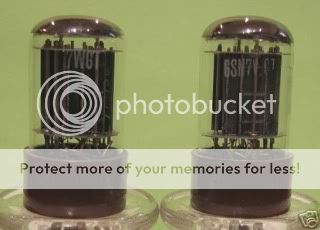
Yeah, I spent some time looking for some of these without success..
- Status
- This old topic is closed. If you want to reopen this topic, contact a moderator using the "Report Post" button.
- Home
- Amplifiers
- Tubes / Valves
- The search for the ultimate 6SN7
